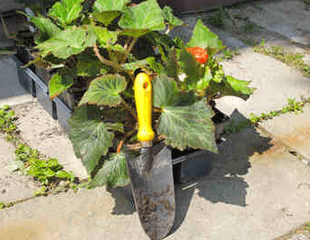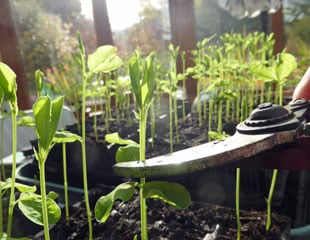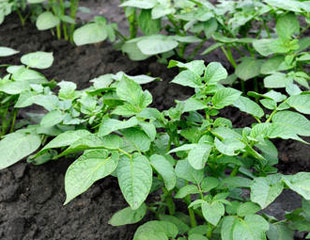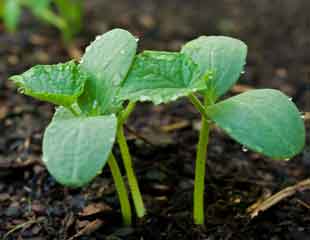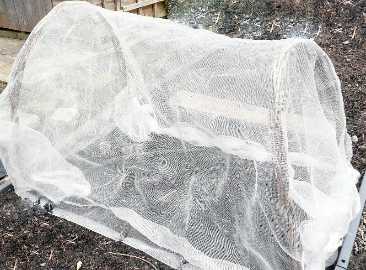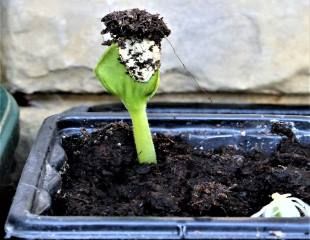
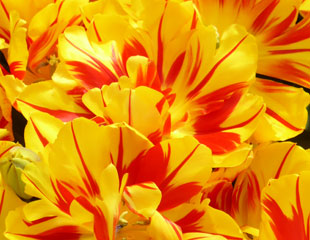
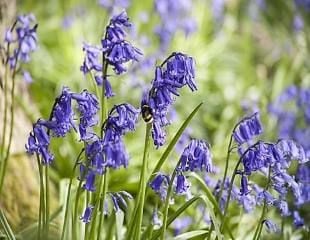
What to do in the Garden in April
April at a glance
- Keep bedding plants frost free
- Prune Hydrangeas
- Prune winter flowering Jasmine
- Sow sweet peas and other hardy annuals
- Sow under glass tender annuals and vegetables
- Plant early potatoes
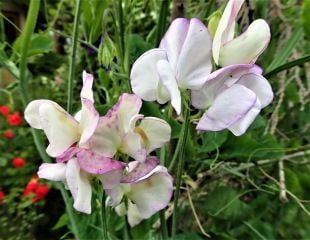
In April the weather remains unpredictable and we can have anything from a heatwave to ground frosts and sleet; be prepared. The best protection for tender veg and bedding plants is cloches or a horticultural fleece. Cover the tender plants until the frost or cold weather has passed.
Conversely, on warmer days, slugs and snails are about and they view the young shoots of Delphiniums, Hostas and lettuce as the equivalent of caviar: protect the new growth- advice on how to beat the slugs.
Add colour to your garden with Shrubs and plants in flower in April.
Buying and Caring for Bedding plants
If you have a greenhouse, lean to or frost free area, you can save money by buying small bedding plants in April, which are cheaper, and grow them on in the sheltered frost free conditions.
Sowing from seed can be time-consuming and tricky; both on the web and in garden centres there is a great choice of plug plants for bedding and vegetables. These small plants need a frost free environment, and as much all round light as you can achieve, (greenhouse, conservatory, window sill or porch.) Take care with watering, too much at the early stages and the small plants can rot. It is best to increase watering slowly as the plant grows. When the plug plants arrive, they are often in small thumb sized pots.
These small plug plants need to be potting on immediately, but take care to pot them up just one stage in pot size. If you put a small plug plant into a large pot, it will not thrive. If the plants are small, you need to escalate the pot size gradually. If you are going to plant the plugs in containers or hanging baskets, (as opposed to borders,) once the plants are more established, it's a good idea to plant them in the container and grow on in the greenhouse until ready to plant out. This will help the plants establish a good root system in the container before placing outside.
When growing bedding plants nip out the growing points to produce a bushier plant, otherwise some plants, particularly petunia, fuchsia, verbena will grow leggy later in the season. Advice on planting out bedding plants and the best bedding plants to grow.
Crocus has a great selection of spring and summer bedding plants.
When to plant out bedding plants?
The rule of thumb is do not plant out bedding plants until risk of frost has passed. Depending on where you are in the country, this is likely to be towards the end of May. You can plant out earlier, but monitor the weather, and if frost is forecast, you will need to protect with a cloche or fleece.
Most bedding plants are not hardy which means they will not withstand a frost which could severely set back the plant, or even kill it.
What to do with garden waste
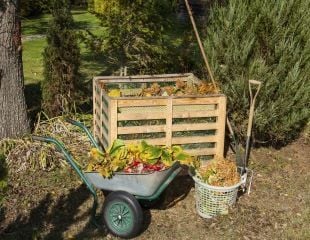
As the debate around climate crisis heightens, we gardeners are becoming more aware of the need to garden in an eco friendly way.
Avoiding peat in compost is one way - What is peat free compost and how to use it.
Another is to make your own compost and, as illustrated left you can use some odd bits of wood to make a slatted container for compostable waste. It is best sited in a not too conspicuous spot, as compost bins are not that pretty, but it needs sun to get hot.
There is a full article on how to make healthy compost, with tips and images on the blog.
Pruning in April
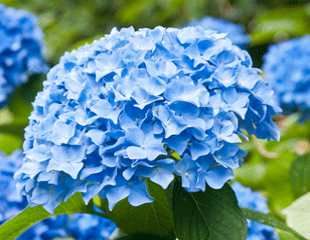
Early April is a suitable time to prune Hydrangea Macrophylla, the common Hydrangea, and the image left may help you identify H. Macrophylla usually with flowers which are pink or blue, but also white. If it is an established Hydrangea prune down to a bud or a pair of buds and cut out about a third or a quarter of the older, more woody growth each year to make for new growth. If the Hydrangea is newly planted, just prune down to a bud until the plant is more established with plenty of growth. Hydrangea is a lovely shade tolerant, summer flowering shrub. tips about growing different types of Hydrangea
It's not too late to prune Buddleia davidii which helps to keep them in shape and flowering. Advise on how to grow and prune Buddleja.
April is also the time to prune, or rather trim, Lavender, including both French L. Lavender Stoechas, and Cotton Lavender (Santonia species). Prune Rosemary and Sage and as with Lavender, avoid cutting into the woody parts of the plant. It's a good idea not to prune anything during severe weather and delay pruning if spring is poor. April is the last chance to prune Cornus. By pruning hard in March /April, Cornus will have a strong red colour next winter. This is a hard prune, cut down to within a few buds to the base.
Early flowering Erica (Heather) can be trimmed back once flowering has finished.
Pruning Shrubs in April What to prune and what not to prune
It's tempting to prune in April, to tidy everything up for the Spring. But it is very important to know which shrubs to prune in April and which to leave alone until later in the year.
Prune the wrong shrub at the wrong time and chances are it will not flower. This short video gives some more tips..
Growing sweet peas
March and April are suitable times to sow, and to plant out sweet peas. It is hard to beat sweet peas for colour, height and scent in a garden. Sweet peas like moisture and are best planted in an area not too dry as that will encourage mildew. If you have time, line the trench with newspaper to aid moisture retention. Sweet Peas are hungry plants and adding lots of organic matter will improve the soil and help with moisture retention. I also add a mulch to help retain moisture as dry ground is really not good for Sweet Peas. Sweet peas are time consuming to grow, but very rewarding.
For tips about growing sweet peas including how to keep them flowering, and how to get straight stems and a video on how to plant and grow sweet peas.
Sweet Peas grown under glass in sheltered conditions need to be hardened off before planting outside, see how to do this below. It is advisable not to plant out during a chilly spell, this can knock back sweet peas (and any other young plants veg or bedding) and if conditions are poor and cool, they could take weeks to pick up. If it's cool better the Sweet Peas hang around in pots for longer. Once Sweet Pears are hardened off do not worry too much about the weather, Sweet Peas are half-hardy annuals and will tolerate a fair degree of chill.
How to pinch out Sweet Peas
If you are growing from seed or buy Sweet Peas as small plants, a good tip is to pinch out the growth point. This will make the plant send out extra shoots, prevent it getting leggy and make a bushier plant with multiple flowering stems instead of just the one. This is shown in the image above, the growing point is being cut off to encourage the plant to bush. With spring sown sweet peas you should do this at least once.
This short video shows exactly how to do this for better bushier Sweet Pea plants.
Seed and Grow summer annuals

Another great summer annual is Cobaea scandens, known as the Cup and Saucer plant. The advantage of sowing annuals is that you can buy a wide range of seed and grow plants you rarely see in garden centres. Cobaea Scandens is native to South America, it is tender (non hardy)and a lovely climbing plant to have as part of a summer display. The specialist seed catalogues have a fantastic range of seeds and its great fun to grow something unusual. Amaranthus caudatus, common name Love lies bleeding, is another exotic looking annual which is easy to grow from seed.
Both need warmth to germinate and to grow on in frost free environment. It is best to delay planting out until they are good-sized study plants.
Easy annuals to grow from seed which provide an equally bold splash of colour are nasturtiums, sunflowers, calendula and cornflowers. All are easy to germinate from seed and not as tender as Cobaea and Amaranthus.
Feed shrubs
As the soil warms up and everything starts growing, April is a good time to give garden shrubs a feed just as the growing season is starting. Sprinkle a general fertiliser around the base of all the shrubs and plants. Suitable fertilisers would be blood fish and bone, Growmore, Chicken Manure and slow release pellets. Handle with gloves and don't do on a windy day unless you want to sprinkle yourself with blood fish and bone. Dig in gently just under the surface and if rain is not imminent, water in as well.
Some shrubs such as Camellias, Rhododendron, Magnolia need a specialist ericaceous feed and for Roses a specialist rose feed is best.In some parts of the country roses maybe putting on a good bit of foliage and growth. April is often a good time to give roses a preventive spray against the many diseases they can suffer from. I grow roses in far from ideal conditions, acid soil, wet ground, and not the sunniest of areas. Roses will grow in these conditions but are more prone to disease, which is why a preventative spray early in the year helps.
Tie in new plant growth
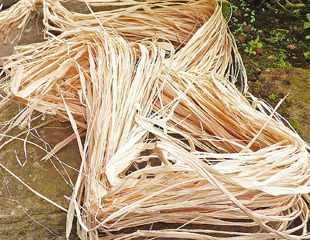
New growth on plants and climbers will benefit from being tied in. Over the years I have tried many types of plant ties, simple string, bendy ones, green metal ties and in the end I prefer simple raffia ties. Raffia is very strong, doesn't look too intrusive on the plant, cheap, easily available and doesn't look offensive if it blows around or ends up in the compost heap. Raffia is also soft and forgiving as a tie and if you wonder why that is a good idea, check out the obvious mistake tomato tie.
As the flowers fade on Tulips and daffodils, dead head the actual flower, but leave the foliage to die back naturally and do not tie it up, as the foliage aids feeding bulb for flowering next year.
If you have had baskets of indoor bulbs, these can be planted out after flowering for display in the garden next year except for Tulips which are best treated as annuals. Always plant bulbs 3x depth of the bulb.
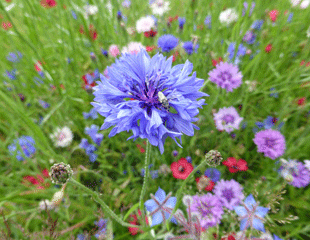
Why not sow a wildflower patch?
A wildflower patch creates a splash of colour and you don't need lots of room and time. There is a simple way to create a wildflower patch by using a pre-seeded roll or matting, which is quick, easy and foolproof. If the idea of having a wildflower patch appeals, but it always seems much too much like hard work when seen on TV/mags, try this easy way - for detailed step by step growing guide follow the link to wildflowers. Whether using a pre-seeded roll or seed, the area needs to be free from weeds and the soil warm enough for germination.
Caring for Hellebores
Hellebores are fading and depending on how they look, time to cut down the stems. The new growth can be seen at the base of the plant and care is needed to ensure this is not snipped instead. The taller Hellebores, argutifloius - the Corsican hellebores, is prone to flop all over the place by this stage and is hard to stake. It is best chopped taking off the flower and stalks down to the ground although the other types Hellebores can be left alone.
Stake Perennials
Many Perennials will need support and early April is the time to stake Perennials, especially the early flowering ones, such as Peonies. If staking is left too late, it can be difficult to place the stakes over, or around the plant, without damaging the emerging plants. I always leave it too late and find myself in May when plants have lots of top growth, trying to thread through a suitable support, and there is a real risk of damaging the plant.
This short video shows how to stake Peony and other perennial plants.
Harden off plants
Plants grown in protected conditions such as those newly purchased from the garden center or grown in a frost and wind free greenhouse, willnot do well if they are planted outside without a period to "harden off". This means gradually acclimatising the plants to the weather. On mild days in April, put the trays of bedding plants and tender veggies outside and bring back in at night under shelter or glass. Over a period of time gradually extend the time outside until eventually the plants are only inside /or covered, in the event of frost.
Lawns tips
April is good time to feed the lawn with High nitrogen fertilizer after scarifying. By April many lawns will have had their first cut it is important to have the blades high to start with and lower as the spring and summer moves on. For all year round advise on maintaining a good lawn and ideas on growing a summer maze.
April in the Veg plot
Start planting out potatoes
April is the traditional month for planting out salad and early potatoes. Late April is good for second early potatoes and for planting Maincrop, which means potatoes can be chitted throughout the month ready for planting out. Whilst it is good to get the potatoes planted, no gardening rules are hard and fast, and as always advice is tempered by the weather. If there is a cold spell delay planting until later in the month. Advice on how to plant and grow potatoes.
Potatoes take up a lot of space in the veg plot, and if space is at a premium, potatoes are easily grown in large pots.
Remember that the top growth on potatoes, the haulm, is vulnerable to frost and will need protection if frost strikes. Cover with a fleece or cloche. Also, given that April and May can be among our driest months, it is important when growing potatoes not to let the tubs or containers dry out. If you are only growing a few potatoes, you can plant them all out together later in April. There are many other vegetables which are suitable for growing in containers.
Which Vegetables to Sow in April, and where, inside or out?
For April planting, it is important to distinguish between the hardier veg and the more tender.
In sheltered areas in April you can plant outside the hardier vegetable such Broad beans, beetroot, carrots, Swiss chard, summer cauliflower, kohlrabi, lettuce, leeks, radish, turnip, spring peas and perpetual spinach.
Tender vegetables will need to be protected which means germinated and grown on under glass, in a greenhouse or conservatory. Tender vegetables include courgettes, squash, peppers, tomatoes, cucumbers, aubergines, celery, celeriac, French beans, sweetcorn and globe artichokes. Only plant out when the risk of frost has passed.
To prevent the problem of leggy seedlings, if germinating on a windowsill, physically turn the seedling container around each day. This is because when the light comes from one source on one side, i.e. a windowsill the seedlings will grow to the light which can make them leggy. By regularly turning the pot around, it helps to reduce this.
April is also a suitable time to sow in the greenhouse, for planting out later, Peas, and beans-French Green and Runners. To avoid gluts later in the season, sow at regular intervals so the plants flower and fruit at regular intervals.
All peas and beans need a long root run and are best in root trainers which are quite expensive, or toilet roll holders which are cheap. Tips and advice on growing peas and beans.
The planting order for the bean family is that Broad Beans can be planted out in March/April as they are the hardiest of the bean family, followed by Runner beans and French beans if it is sheltered or in May with frost protection.
Which vegetables to plant out in April
If the conditions are right and the soil has warmed up, you can sow directly into the veg plot the hardier vegetables such as carrots, broad beans, onions, garlic and purple sprouting broccoli. Carrots always need protection against carrot fly and this needs to be a physical barrier such as euro mesh, as in the image. Carrot fly will severely damage the crop, and although it is a nuisance to erect mesh around the crop, it is the best protection. Specialist varieties of Carrot such as 'Flyaway' are less vulnerable to carrot fly, but not guaranteed free. Aim to sow or plant veg successively, every fortnight works well.
If you notice that the carrot seed has failed to germinate it maybe because the soil is too cold and sow again later. Carrots can be slow, and sometimes difficult to get going, but trouble free once they have germinated.
If you are companion planting, April is a good time to sow say, poached egg plants, but only once the veg are in situ, as poached egg plants are great for pollination but they will not transplant.
April is a suitable time to plant out strawberries either in the veg plot or containers, but remember to protect from the birds later when the fruits show. For an earlier crop of strawberries, cover the plants with a cloche but do not forget to water under the cloche. Strawberries are fully hardy and can be left in the veg plot all year round.
April is time to plant onions and garlic both of which are easy crops to grow. Simply plant to the correct depth in a sunny spot and they grow themselves. A great advantage of growing your own garlic is that the choice of varieties available on sale to grow now is extensive. Both onions and garlic store really well so will over winter ensuring you have a plentiful supply of both for months, well into the following winter.
Video guides: how to plant onions and garlic and growing tips and planting beans of all types and advice on germinating from seed.
How to pot up Seedlings
Seedlings of vegetables sown earlier, such as tomatoes, and cucumbers may be ready for potting on. To do this, select another plant pot which is just a little bigger by a few centimetres and fill with compost. Press down gently on the compost to remove air pockets which present little vacuums for the tiny roots. Lift the seedling out gently by its leaves, not stem, sink into the pot. If the seedling has gone leggy (long spindly stem) sink it in deeper, fill in and water gently. It's very tempting to put into a larger pot but small seedlings will not thrive in big pots. This means, for example, when growing of tomatoes, it may be necessary to pot on 2/3/4 times to place in the eventual container or grow bag. Video advice on How to pot on tomatoes
Start growing Herbs
Herbs bought in the supermarket are expensive and don't seem to last very long. April is also the time to sow, under glass, tender herbs such as basil, coriander, dill, Thai basil, and tarragon which you can plant out later in the year or carry on growing in pots in a sunny spot. If you are sowing Parsley and struggle to get it started, keep sowing, it can be tricky to get going but trouble free once it germinates.
video how to make an easy herb garden
Growing your own herbs enables you to grow different and interesting varieties which can be hard to find in the supermarkets such as Thai basil, which is just as easy to grow as regular basil and gives a great flavour to stir-fries.
Hardy herbs can be planted out in pots or in the veg plot such as chives, thyme and Oregano. A word of warning about growing Oregano, (also known as Marjoram) Botanical name Origanum. It is lovely, aromatic, great in Greek salads, easy to grow and tolerates most conditions except extreme wet and it is very attractive to bees and insects so a great wildlife friendly plant. The drawback is that it is vigorous and will self seed around the garden and you will need to be vigilant to pull out any new plants if you don't want an Oregano garden. Most herbs need a sunny spot in the garden, but there are some herbs which are Shade tolerant.
Check out my Blog about Starting a Culinary Herb Garden

